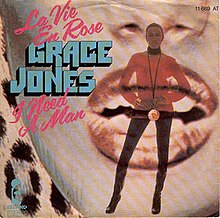La vie en rose
| "La Vie en rose" | ||||
|---|---|---|---|---|
| Single by Édith Piaf | ||||
| from the album Chansons Parisiennes | ||||
| B-side | "Un refrain courait dans la rue" | |||
| Released | 1947 | |||
| Format | 10" | |||
| Genre | Traditional pop | |||
| Label | Columbia | |||
| Writer(s) |
Édith Piaf (lyrics) Louiguy and Marguerite Monnot (melody) |
|||
| Édith Piaf singles chronology | ||||
|
||||
| "La Vie en rose" | ||||
|---|---|---|---|---|
 |
||||
| Single by Grace Jones | ||||
| from the album Portfolio | ||||
| B-side |
|
|||
| Released | October 1977 | |||
| Format | ||||
| Genre | Bossa nova | |||
| Length | 7:27 (album version) 3:35 (single version) |
|||
| Label | Island | |||
| Writer(s) | ||||
| Producer(s) | Tom Moulton | |||
| Grace Jones singles chronology | ||||
|
||||
| "La Vie en rose" | ||||
|---|---|---|---|---|
| Single by Donna Summer | ||||
| from the album Tribute to Edith Piaf | ||||
| Released | 1993 | |||
| Format | 12", CD | |||
| Recorded | 1993 | |||
| Genre | R&B | |||
| Length | 4:58 | |||
| Label | AB Disques | |||
| Writer(s) | Édith Piaf, Louigny, Mack David | |||
| Producer(s) | Jacques Arnoul | |||
| Donna Summer singles chronology | ||||
|
||||
"La Vie en rose" (French pronunciation: [la vi ɑ̃ ʁoz]) was the signature song of popular French singer Édith Piaf, written in 1945, popularized in 1946, and released as a single in 1947. The song became very popular in the USA in 1950 with no fewer than seven different versions reaching the Billboard charts. A cover version in 1977 by Jamaican singer Grace Jones was also a successful international hit. "La Vie en rose" has been covered by several artists over the years, including a 1950 version by Louis Armstrong and a 1993 version by American singer Donna Summer. Harry James recorded a version in 1950 on Columbia 38768.
The song's title can be translated as "Life in Rosy Hues" or "Life Through Rose-Tinted Glasses"; its literal meaning is "Life in Pink".
The lyrics and melody of the song were written by Édith Piaf herself, but the melody was said officially to have been composed and registered by Louiguy only, since at the time, due to the stringent registration requirements of SACEM, Piaf did not have the necessary qualifications to be able to copyright her work with SACEM. Piaf offered the song to Marianne Michel, who slightly modified the lyrics, changing "les choses" ("things") for "la vie" ("life"). In 1943, Piaf had performed at a nightclub/bordello called "La Vie en Rose". Initially, Piaf's peers and songwriting team did not think the song would be successful, finding it weaker than the rest of her repertoire. Heeding their advice, the singer put the song aside, only to change her mind the next year. The song was performed live in concert for the first time in 1946. It became a favorite with audiences. "La Vie en rose" was the song that made Piaf internationally famous, with its lyrics telling about the joy of finding true love and appealing to those who had survived the difficult wartime.
"La Vie en rose" was released on a 10" single in 1947 by Columbia Records, a division of EMI, with "Un refrain courait dans la rue" making the B-side. It met with a warm reception and sold a million copies in the USA. It was the biggest-selling single of 1948 in Italy, and the ninth biggest-selling single in Brazil in 1949. Piaf performed the song in the 1948 French movie Neuf garçons, un cœur. The first of her albums to include "La Vie en rose" was the 10" Chansons parisiennes, released in 1950. The song appeared on most of Piaf's subsequent albums, and on numerous greatest hits compilations. It went on to become her signature song and her trademark hit, sitting with "Milord" and "Non, je ne regrette rien" among her best-known and most recognizable tunes. Encouraged by its success, Piaf wrote 80 more songs in her career.
...
Wikipedia
